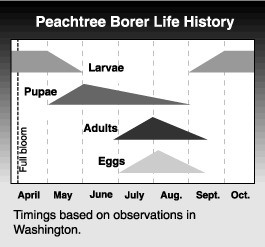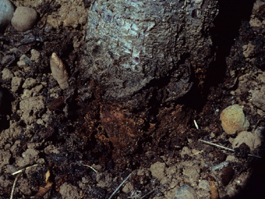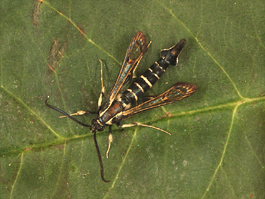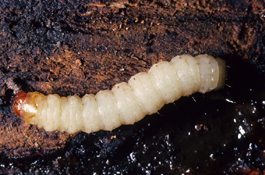by Jay F. Brunner and Donald Rough, originally published 1993
Synanthedon exitiosa (Say) (Lepidoptera: Sesiidae)
Hosts
Before peaches were grown commercially, the peachtree borer survived on wild plum, cherry and related plants. It will attack commercial peach, cherry, prune, apricot, nectarine and plum orchards.
Life stages
Egg
The egg is a flattened disk shape, about 1/50 inch (0.5 mm) in diameter. It is reddish brown and is deposited singly or in small groups, usually near the base of the tree.
Larva
The larva is white or cream with a yellow-brown to dark brown head and three pairs of segmented legs. It measures about 1-1/2 inches (38 mm) long when fully grown.
Pupa
The female pupa is about 3/4 inch (18 mm) long, slightly larger than the male pupa. It is darker colored than the male and develops an orange band on the abdomen.
Adult
The adult is a dark blue, clear-winged moth. The female is slightly larger than male and has bands of bright orange scales on the fourth and fifth abdominal segments. On the male, some abdominal segments may be fringed with white or yellow scales.
Life history
 The peachtree borer overwinters as a larva on or under tree bark, usually below ground. It becomes active when soil temperatures reach 50ºF and feeds on live tissue under the bark. When full grown, the larva builds a cocoon and pupates in May and June. Moths begin to emerge in late June to early July and continue into September.
The peachtree borer overwinters as a larva on or under tree bark, usually below ground. It becomes active when soil temperatures reach 50ºF and feeds on live tissue under the bark. When full grown, the larva builds a cocoon and pupates in May and June. Moths begin to emerge in late June to early July and continue into September.
Female moths mate shortly after emerging and within 30 minutes start laying eggs. Most eggs are deposited the day of emergence and mating. Females live about 6 or 7 days but lay few eggs after the third day. Eggs hatch in 9 to 10 days and the young larvae bore into the bark at the base of the trunk. Once beneath the bark, they feed in the cambium layer.
Damage

The main damage is done by larvae feeding on the cambium tissue, which is the layer of living cells between the wood and the bark. Damage is usually confined to the trunk, from a few inches above to a few inches below ground level. Young trees can be killed if they are completely girdled by larval feeding. Older trees are less likely to be girdled, but injury can lower vigor, making them vulnerable to other insects, diseases and conditions that contribute to their death. Infested trees bleed frass infested gum from damaged areas during the growing season.
Monitoring
Initial and peak emergence of adult males can be monitored with pheromone traps. Larval feeding is difficult to detect because much of it is at or below ground. The only way to positively identify the borer, apart from trapping, is to dig out the suspected attack using a knife or heavy screwdriver. A light brown frass and soft, sticky sap will be found where there is fresh feeding activity.
Biological control
Several species of parasitic hymenoptera have been reared from larvae or pupae of the peach tree borer. They include Bracon sanninoideae and Macrocentrus marginator (Braconidae); Cryptus rufovinctus, Phaeogenes ater, and Venturia nigricoxalis (Ichneumonidae); Syntomophyrum clisiocampae (Eulophidae); and Telenomus quaintacei (Scelonidae).
Management
Summer insecticide treatments are effective in controlling this pest. Apply sprays by handgun to the tree trunk and ground around the base of the tree. Normally, two applications are needed, one in early July and another one month later. Do not apply pesticides to cultivars that are scheduled to be harvested within the preharvest interval. The use of pheromones in a mating disruption program is an effective control.


